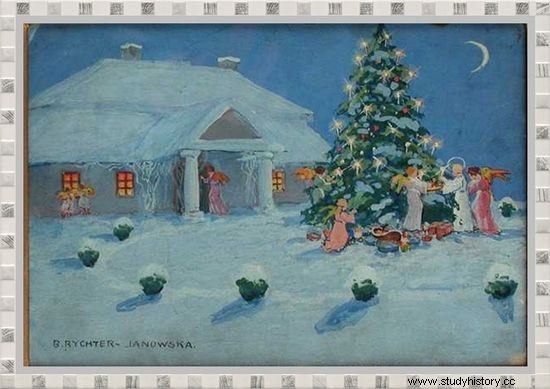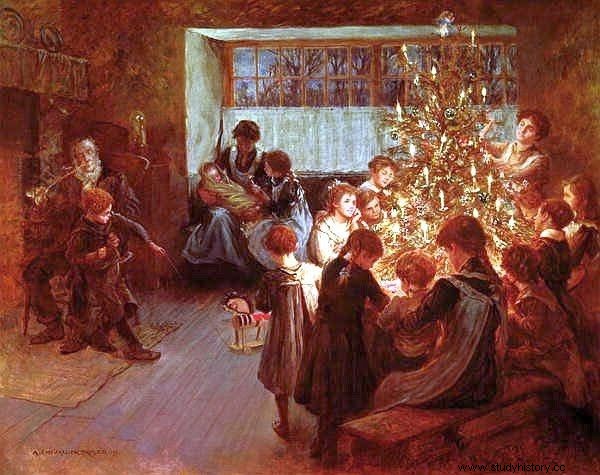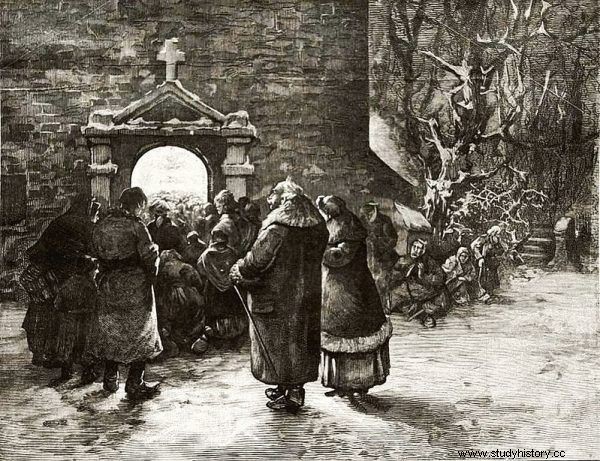Today Christmas is associated with the fever of pre-Christmas shopping, listening to radio hits and Kevin, who stays home alone every year. However, among these commercial customs we can also find a whole range of traditions without which we cannot imagine this special time.
These customs survived thanks to the refuge of Polish culture, which was the manor house. The turbulent fate of our country has never shaken its stability. The time in it seemed to flow with its uninterrupted rhythm, and the holiday season was celebrated in a special way. And not that different from many of our customs today.
Time for pre-holiday preparations
"In the Polish tradition, Christmas was called Christmas, referring only to holidays or the entire period of the so-called duodenum, i.e. 12 days from Christmas Eve to January 6 - the feast of the Epiphany (in the Catholic tradition the Epiphany). The Christmas season, on the other hand, began on the first Sunday of Advent and ended on the Saturday before the Sunday of Seventieth (Old Ordinary) . This period consisted of:Advent, the Christmas octave and the time of Epiphany.
The season of Christmas preparations at the court very often started in November. However, it was with the advent of the first Advent Sunday that "noisy parties, balls, grand receptions, weddings ceased" and were replaced with fasting and morning rants . The children spent their days making Christmas decorations, and the ladies of the house planning, shopping and managing Christmas preparations. There were a lot of things to be arranged, from the Christmas Eve menu, through the preparation of gifts, to the reception of guests who traditionally came to the landed gentry for the holidays.

Decorating a Christmas tree is still one of the most important Christmas traditions
One of the obligatory elements of these preparations was going to town for Christmas shopping . The lists of errands included gifts for children and family as well as for people working in the court. Nobody was forgotten during the holiday season. Thanking for their work, the owners of land estates gave gifts to all those involved in running them. The gifts included, among others, "dried fruits and pieces of clothing:scarves, gloves, shirts or fabric for dresses".
However, not only gifts were bought in the city. It also brought sweets, fruit and delicacies for the court, as well as Christmas decorations, including angel's hair and baubles, then called silver balls.
The green lady in the secret room
The custom of decorating the Christmas tree came to us from beyond our western border in the 19th century and very quickly settled under noble roofs. The trees were decorated primarily with edible ornaments, such as apples, gingerbread, gilded nuts, carob, and chocolate and marzipan delicacies. All this was supplemented with chains and small ornaments, hand-made by children under the supervision of nannies or governesses.
On Christmas trees, you could also find purchased decorations, but not in such a large amount. Christmas balls, because we are talking about them, were initially imported from abroad, mainly from Germany. And this led to their boycott after regaining independence in 1918, when patriotic ornaments of Polish production became fashionable.
The Christmas tree itself appeared in the court the day before or on Christmas Eve morning. Tall, spread and beautifully fragrant stood in the living room. Under its branches, it hid gifts from Angel, Star or St. Nicholas, who, depending on the region, visited noble houses. Decorated trees were carefully hidden from the youngest inhabitants. They could see their beauty and hidden gifts only after their Christmas Eve dinner.
Christmas Bread
Although the custom of the Christmas tree is not a native tradition for our country, starting the Christmas Eve dinner with breaking the wafer, yes. It is a tradition
[...] referring to the practice of taking home blessed bread (the so-called eulogia), cultivated in the first centuries of Christianity, for those who could not participate in the service.
Over time, this bread turned into a wafer, which at the turn of the 18th and 19th centuries began to appear on Christmas Eve tables in noble manors.

We prepare most of the Christmas Eve dishes typical of a gentry manor until today
Baked in parishes and in monasteries, they were distributed in the week before Christmas Eve by a churchman or organist, and they appeared in various colors. White was the guest most often at festive tables, while colorful wafers were offered to animals on the night before Christmas.
In Galicia, it was customary to give cattle a yellow wafer, believing that cows would give yellow, or fat, milk to cows, while horses had a red wafer to protect them from worming. The dog was given a wafer with peppercorns, thanks to which he was to be a formidable and vigilant guardian of the farm.
The wafers were also used to create intricate ornaments called worlds. They had geometric shapes, which were obtained by joining previously cut elements with saliva and hanging them on linen threads.
Like on Christmas Eve, all year round!
There were also customs associated with the Christmas season to ensure prosperity in the coming year. "The specific character of Christmas Eve was influenced by old Slavic customs, such as the worship of the deceased ancestors or the magic of fertility."
Christmas beliefs found their followers both in the peasant hut and in the lord's court. For example, it was believed that a girl who spawned poppy seeds for Christmas Eve in the coming year would get married. Others concerned Christmas Eve dishes, the tasting of which was supposed to guarantee happiness and success ..
When the ladies and servants spent the day preparing the evening dinner, the gentlemen usually decided to sneak out of the house and go hunting. This custom was related to another belief that "if a hunter hunts something on Christmas Eve, he will not come back from hunting empty-handed during the year either".
However, the most popular belief that persists to this day is the saying "as on Christmas Eve, so all year round." For this reason, the day was started early and was spent in a busy atmosphere to ensure that there would be no quarrels and no laziness during the coming twelve months.
At the Christmas table
While the servants made the last preparations for supper, tuning the dining room and making sure that all dishes were prepared on time, the residents of the court changed into festive clothes and looked for the first star. With its arrival, the whole family and invited guests sat at the table, under the tablecloth of which hay was hidden, which had a great impact on the stability of the dishes and the overturning of the glasses.
After breaking the wafer, it was possible to start dinner. Carp did not play the first violin in the Lenten Christmas menu. On the other hand, fish from local lakes, such as zander, tench and pike, predominated .
The exemplary Christmas Eve menu includes such dishes as:
Borscht with dumplings
Almond soup
Pies with eggs and milk on shells
Pike with horseradish
Fried rope
Cabbage with mushrooms
Łamańce with poppy seeds
Is:
Borscht with dumplings
Fish soup
Gray carp
Rope fried with horseradish
Compote with dried plums
Almond pudding with schodon
Kutia
And all this was complemented by delicacies such as delicacies, grapes, apples, preserves, chestnuts and large amounts of all alcohol.

Shepherdess in the nineteenth century
When the meal was over, the whole party moved to the previously locked lounge. There, with the joyful shouts of children and the aroma of brewed coffee and tea served with cake, gifts were handed out, Christmas carols were sung and the departure for the midnight mass was awaited.
However, it was not a peaceful sleigh trip, but a crazy race between the hosts. According to tradition, whoever first entered the temple would spend the coming year in abundance and fertility.
Holidays and post-holidays
The following days, until the New Year's Eve and Epiphany, were filled with Christmas visits, games and caroling. Carol singers with a live nativity scene wandered around mansions and cottages, reenacting biblical scenes in exchange for small gifts. There were also sleigh rides, which were taken from manor house to manor, feasting and emptying the landed gentry's pantries.
The festive season naturally turned into a carnival, the attractions of which were filled with long winter nights. And so it was time to wait for spring to come, and with it to start the next growing season.
Bibliography:
- M. Łozińska, In the manor house. Everyday, customs, a celebration of fun, Polish Scientific Publishers PWN, 2010
- T. A. Pruszak, On gentry celebration. The traditions of Christmas and Easter, Polish Scientific Publishers PWN, 2011
- E. Kowecka, In the living room and in the kitchen. A story about the material culture of Polish palaces and manors in the 19th century, Zysk i S-ka Wydawnictwo, 2008
- http://www.muzeum.lasochow.pl/boze_nareniem_w_dworze.html, 17/12/2019
